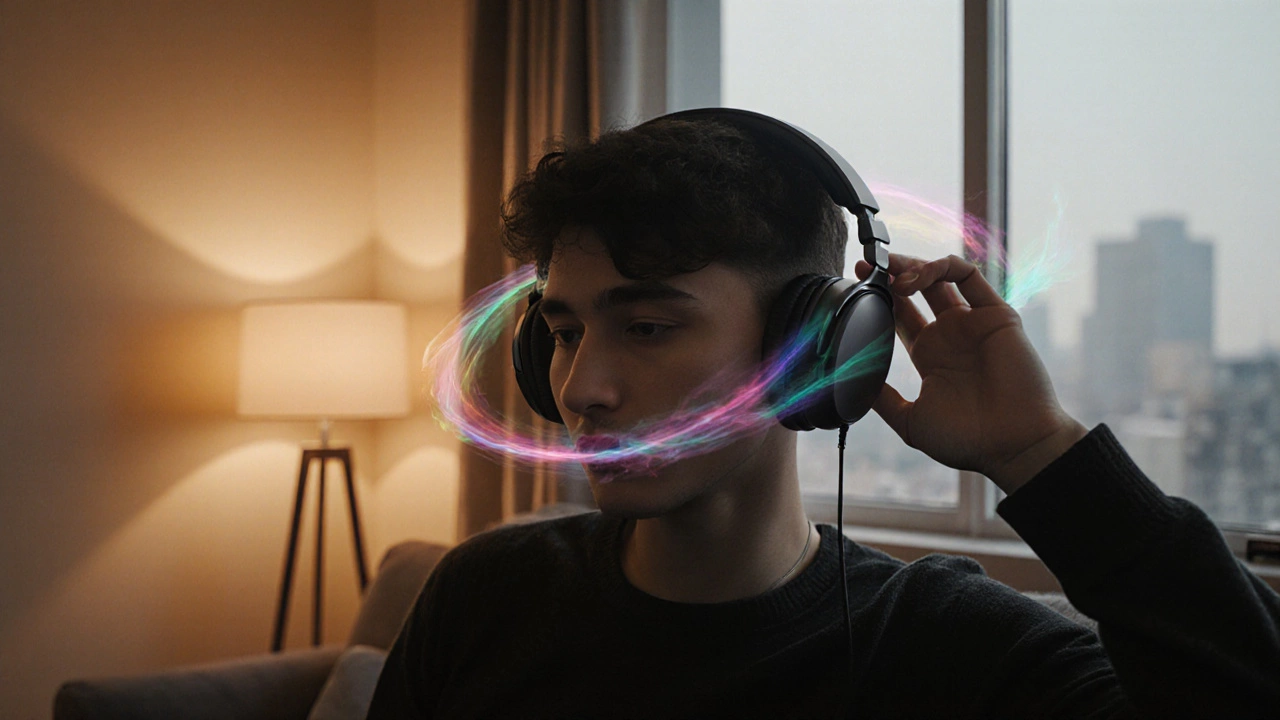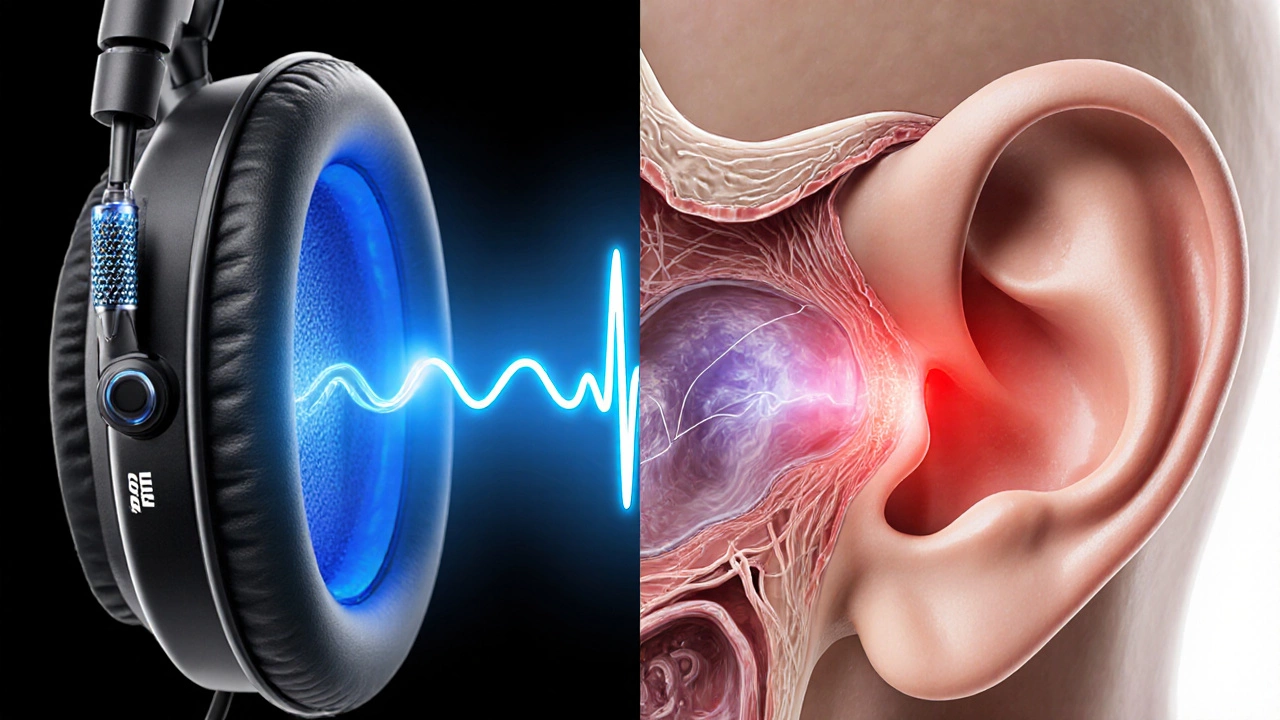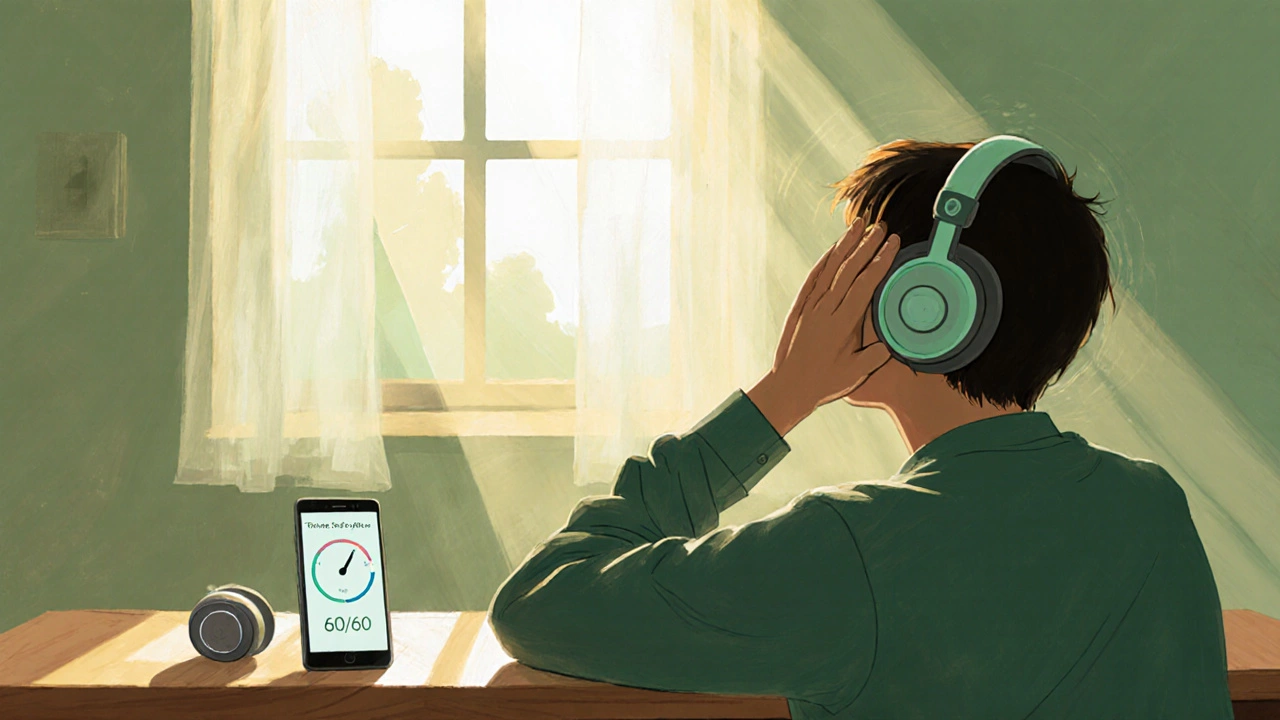
Safe Listening Calculator
Safe Listening Calculator
Calculate if your headphone listening habits are within recommended safe limits to prevent tinnitus and hearing damage.
Your Listening Habits
Volume: %
Duration: minutes
When you slip on a pair of Noise-cancelling headphones are a type of audio gear that reduces ambient sounds by generating sound waves that cancel out external noise. Many users love the quiet they provide, but a lingering question is whether that silence could trigger tinnitus - the perception of ringing or buzzing without an external source.
Below, we break down what tinnitus actually is, how noise‑cancelling technology works, which factors might push you toward ringing ears, and practical steps to keep your listening experience safe.
What Is Tinnitus?
Tinnitus is a symptom, not a disease. It describes phantom sounds - ringing, hissing, or humming - that originate inside the auditory system. According to the American Tinnitus Association, about 15% of adults experience it at some point, and 1-2% suffer chronic, debilitating forms.
The underlying mechanisms vary: damage to tiny hair cells in the cochlea, altered neural firing patterns, or even vascular issues. An audiogram (a chart of hearing thresholds across frequencies) often reveals the frequency range where the brain is compensating for lost input, which can manifest as ringing.
How Do Noise‑Cancelling Headphones Work?
There are two main approaches:
- Active noise cancellation (ANC) uses built‑in microphones to pick up external sounds, then a tiny processor creates an "anti‑noise" waveform that destructively interferes with the incoming noise. This reduces perceived sound pressure level (SPL) by 20‑30 dB in the low‑frequency range.
- Passive noise isolation relies on physical barriers - ear cups or in‑ear tips - to block sound. Materials like memory‑foam and over‑ear cushions can attenuate up to 40 dB across a broader frequency spectrum.
Most premium models blend both methods. For example, the Bose QuietComfort 45 and Sony WH‑1000XM5 use multiple microphones and adaptive algorithms that adjust ANC strength based on your environment.
Potential Links Between ANC Headphones and Tinnitus
Researchers have explored several pathways:
- Volume‑related exposure: Even with ANC, many users crank the volume to compensate for perceived loss of detail, especially in noisy settings. Prolonged exposure above 85 dB (A) can cause temporary threshold shifts that, over time, may evolve into permanent damage and tinnitus.
- Ear‑canal pressure: Over‑ear designs seal the ear, increasing the effective SPL inside the ear canal. A sealed environment can raise the sound pressure level by a few decibels, potentially stressing the cochlea.
- Ototoxic factors: Some users pair headphones with high‑intensity bass boosters or use them for long gaming sessions. Combined with exposure to ototoxic substances (e.g., certain antibiotics, heavy metals), the cumulative risk rises.
- Habituation rebound: When ANC removes background noise, the brain may become hypersensitive to any residual sound. Removing the headphones suddenly can make faint ambient sounds feel louder, a phenomenon sometimes reported as “ringing” that mimics tinnitus.
Crucially, no large‑scale longitudinal study has proven a direct causal link between ANC headphones and chronic tinnitus. Most evidence points to misuse-high volume, extended sessions-rather than the technology itself.

Scientific Evidence and Expert Opinions
A 2023 study from the University of Melbourne monitored 120 participants who used ANC headphones for at least 4 hours daily over six months. The researchers measured decibel levels with calibrated ear‑bud microphones and conducted pre‑ and post‑study audiograms. Results showed a statistically insignificant change in hearing thresholds, but 8% reported temporary ringing after long sessions, which resolved within 48 hours.
ENT specialists such as Dr. Amrita Patel (London) echo these findings: “ANC itself isn’t harmful. The risk lies in user behavior-volume, duration, and whether the user already has pre‑existing hearing issues.”
Guidelines for Safe Use
To enjoy the quiet without courting ringing ears, follow these practical rules:
- Adopt the 60/60 rule: Keep volume at or below 60 % of maximum and limit listening to 60 minutes at a time. Take a 5‑minute break after each hour.
- Use the “ambient” or “transparency” mode when you need situational awareness. This reduces the sealed‑in pressure and lets your ears stay calibrated.
- Check your SPL: Many smartphones now display real‑time decibel readings. Aim for under 85 dB (A) for prolonged use.
- Rotate headphones: Alternate between ANC over‑ear, passive in‑ear buds, and speaker listening to give the ear canal breathing time.
- Monitor early signs: If you notice persistent ringing, muffled hearing, or a feeling of fullness in the ears, pause headphone use and schedule an audiology appointment.

When to Seek Professional Help
Persistent tinnitus lasting more than two weeks, especially if accompanied by hearing loss, dizziness, or ear pain, warrants a visit to an audiologist or ENT doctor. They may perform an audiogram, tympanometry, and possibly imaging to rule out underlying conditions.
Treatment options range from sound‑masking devices and cognitive‑behavioral therapy to medication for associated anxiety. Early intervention improves outcomes.
Bottom Line
Noise‑cancelling headphones are not a direct cause of tinnitus, but misuse can create conditions that predispose you to ringing ears. By keeping volume sensible, limiting session length, and staying aware of early symptoms, you can enjoy the silence without sacrificing ear health.
| Feature | Active Noise Cancellation (ANC) | Passive Noise Isolation |
|---|---|---|
| Mechanism | Electronic anti‑noise signal | Physical barrier (cup cushions, ear tips) |
| Effective Frequency Range | Low‑frequency (20‑200 Hz) most effective | Broad (20‑20 000 Hz) |
| Average SPL Reduction | 20‑30 dB | 10‑40 dB |
| Battery Requirement | Yes (typically 8‑30 hours) | No |
| Potential Ear‑Canal Pressure | Moderate (sealed over‑ear design) | Varies (in‑ear tip depth) |
Can low‑volume ANC listening cause tinnitus?
At low volumes, ANC itself is unlikely to damage hearing. Tinnitus risk emerges mainly from prolonged exposure and high SPL, not the cancellation technology.
Why do some users feel ringing after removing their ANC headphones?
When ANC eliminates background noise, the auditory system becomes hyper‑aware of any residual sound. Removing the headphones suddenly re‑introduces ambient noise, which can be perceived as a brief ringing sensation. This is usually temporary.
Are particular headphone brands more likely to cause tinnitus?
No reputable brand (e.g., Bose, Sony, Apple) is inherently more risky. The key factors are how loudly you listen and how long you wear them, regardless of brand.
How can I test if my headphones are set too loud?
Use a sound‑meter app on your phone. Position the phone near the ear cup and play a test tone. If the reading exceeds 85 dB (A), lower the volume or enable volume‑limiting features.
What steps should I take if I develop persistent tinnitus?
Schedule an audiology exam promptly. Early diagnosis can identify treatable causes, and a professional can recommend sound‑therapy, counseling, or medical options tailored to your case.